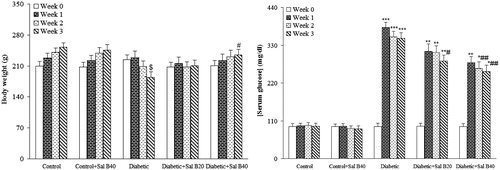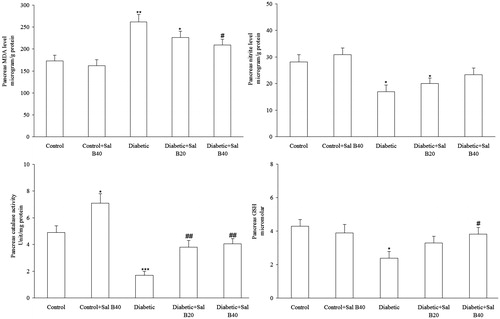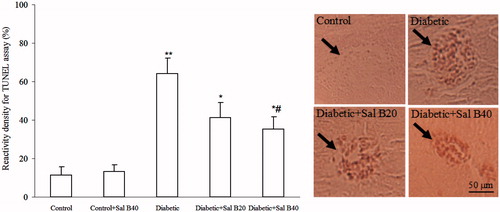Figures & data
Figure 1. Body weight and serum glucose level at different weeks. Sal B20 and Sal B40 indicate salvianolic acid B at doses of 20 and 40 mg/kg, respectively (n = 10–11 for each group). $p < 0.05 (versus week 0), *p < 0.005, **p < 0.001, ***p < 0.0005 (versus week 0), #p < 0.05, ##p < 0.01 (versus diabetic in the same week).

Figure 2. Changes of blood glucose as percentage of initial value (min 0) at different time points in OGTT and serum insulin level. Sal B20 and Sal B40 indicate salvianolic acid B at doses of 20 and 40 mg/kg, respectively (n = 7–9 for each group). *p < 0.05, **p < 0.01, ***p < 0.001 (versus control), #p < 0.01 (versus diabetic).

Figure 3. Pancreas tissue oxidative stress markers. Sal B20 and Sal B40 indicate salvianolic acid B at doses of 20 and 40 mg/kg, respectively (n = 4–5 for each group). *p < 0.05, **p < 0.01, ***p < 0.005 (versus control), #p < 0.05, ##p < 0.01 (versus diabetic).

Figure 4. The number of pancreatic islets/mm2 and their mean area (top panel) and photomicrographs of pancreatic sections stained with H&E (bottom panel) after 3 weeks of Sal B administration. Sal B20 and Sal B40 indicate salvianolic acid B at doses of 20 and 40 mg/kg, respectively (n = 3 for each group). *p < 0.05, **p < 0.01 (versus control), #p < 0.05, ##p < 0.01 (versus diabetic).

Figure 5. Immunoreactivity density for TUNEL assay of pancreatic islets and their photomicrographs on day 5 after diabetic induction by STZ. Sal B20 and Sal B40 indicate salvianolic acid B at doses of 20 and 40 mg/kg, respectively (n = 4 for each group). Each arrow shows a pancreatic islet. *p < 0.05, **p < 0.005 (versus control), #p < 0.05 (versus diabetic).

